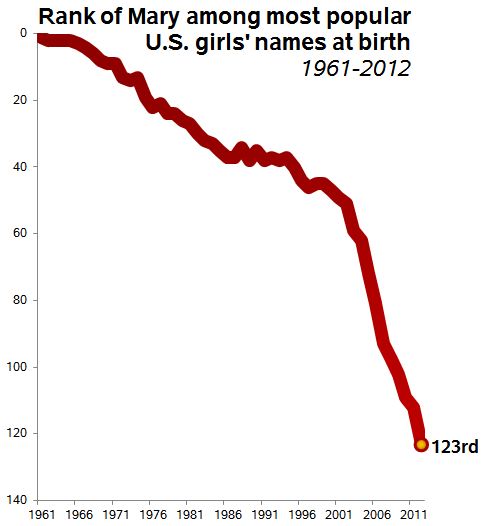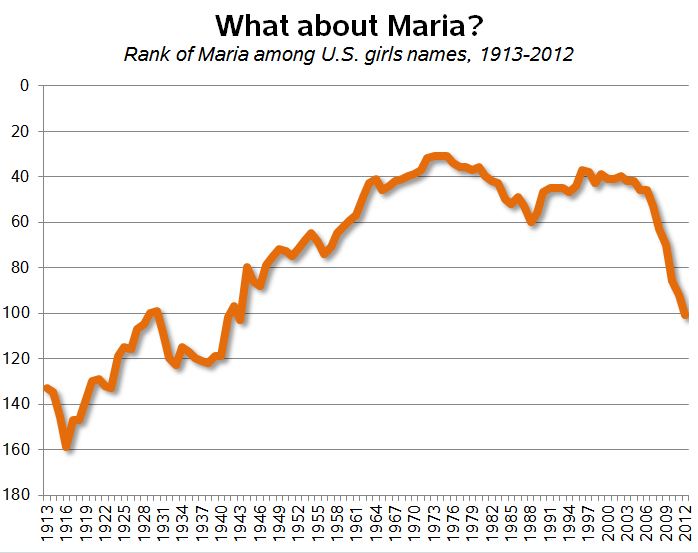For the past two years I’ve been tracking the fate of the name Mary as given to girls born in the U.S., spurred by the observation that Mary was no longer in the top 100 names, after an unparalleled run at #1 that lasted for all but six years of recorded history.
It’s a difficult job, but it’s got to be done. (Follow the Mary tag for historical background, examples, and more figures.)
So: 2012 was another rough year, according to data from the Social Security Administration.
There was another 5% drop in the number of Marys born, and as a result Mary fell a record 11 ranks, from 112 to 123. The 2,535 Marys born in 2012 were a mere 0.13% of the 1.9 million girls recorded born. Once upon a time, in 1880, more than 7% of all girls born were named Mary.
 Part of the point of the Mary name project is to show the predictability of (much) human behavior, even including rare events, such as naming girls Mary. I have a simple model which predicts that the number of girls named Mary will decline at a rate equal to the average decline over the previous five years — what falls continues to fall. This year, out of 1.9 million girls born and 2,535 named Mary, my model was off by a microscopic 79 girls. The model predicted the number of Marys to within 3.2%.
Part of the point of the Mary name project is to show the predictability of (much) human behavior, even including rare events, such as naming girls Mary. I have a simple model which predicts that the number of girls named Mary will decline at a rate equal to the average decline over the previous five years — what falls continues to fall. This year, out of 1.9 million girls born and 2,535 named Mary, my model was off by a microscopic 79 girls. The model predicted the number of Marys to within 3.2%.
Take that, indeterminancy, free will, or postmodernism (your pick).
P.S. Despite the continued free fall of Mary, my model missed low, incidentally — or, Mary-naming Americans beat expectations by 3.2%. Since my Mary post on the Atlantic site last December was shared more than 5,000 times, unless proven otherwise we have to assume the 79-girl bump was a Mary-name-blog effect. (File under reflexivity.)
ADDENDUM: MARIA
By request, here is the trend for Maria. It is not the case that Maria is replacing Mary — both are trouble. In fact, with Maria falling steeply in the last decade, she has also dropped out of the top 100 for the first time since 1943!
Speculation: As Marias of Latina origin grow more common, perhaps their increase is not enough to compensate for the resulting perception among non-Latinas that Maria is a Spanish name. (Remember, this is just girls born in the U.S.)


Phil: I’ve said this before but it bears repeating. I think you need to log the rank, particularly given the constant rate assumption in your model.
LikeLike
I just use the rank in the graph; the model uses the change in the raw number of Marys.
LikeLike
I’d use percent or even the raw number. That curve is less dramatic, showing the major decrease coming in the 1930-1980 period with the rate of decrease tapering off after that. The modal Mary out there is 63 years old.
As for Maria, the Latin overtones are nothing new. In the 1970s, a pregnant friend (Jewish with Jewish husband) asked me what I thought of the name. I muttered something about “West Side Story.” A few months later she named her daughter Joanna. In my own classes, over the decades, I’ve seen a big increases in Hispanic surnames but no Marias that I can recall. (For some reason, I see a lot of Stephanies)
LikeLike
Fair enough. But y’all shouldn’t discount rank so easily. In the popular perception rank may be what people are reacting too when they decide what name to use — if the process is actually reflexive. If it were just a case of ethnicity, for example, so Catholics choose Mary and Jews choose Ruth, then rank wouldn’t matter and it would just be about population composition. But if it’s cultural and people are thinking strategically, then maybe rank matters independently.
LikeLike
I wonder how you would model the popularity of Forrest first name in the XX century, and how well this model would fit the reality 🙂
LikeLike
If a Forrest falls in the 20th century, is it reality? In fact Forrest does decline steadily 1915 to 1985 (the rank going from 200 to 500+), then zooms up – the number going from about 250 to 1350 (rank 200 again) — then drops just as precipitously. In 2011, there were fewer than 200. You can’t see the Forrests for the Jaydens.
LikeLike
According to the Baby Name Wizard Laura Wattenberg, the real trend is the preference to choose an unusual name. There is now NO name so popular that you are likely to be in the same classroom as someone who shares your name. So the broader cultural pattern is towards uniqueness, rather than popular uniformity, in terms of naming — rather than the story of what happened to Mary. see blog post here: http://www.babynamewizard.com/archives/2013/4/what-is-a-popular-baby-name-hint-there-are-fewer-than-you-think
LikeLike
Yes, I wrote about that trend first in a 2009 Huffington Post piece, “On Naming Diversity, or Why We Never Asked if Mary Had Jumped the Shark”: http://www.huffingtonpost.com/philip-n-cohen/on-naming-diversity-or-wh_b_201525.html. But that doesn’t explain why Mary is falling in terms of rank – that name has grown less popular relative to other names.
LikeLike
Weird that Lady Mary is the fan favorite of Downton Abbey but parents are still more likely to name their daughter Violet, and even Cora is gaining fast. We decided that if Mary was good enough for Wollstonecraft, Shelley, Quant, Blige and Timony, it was good enough for our kid (b. 12/30/13). People seem sort of charmed but mystified by it, like they forgot it was a real name, for people who are alive now. I do public records searches for work occasionally and have noticed that a lot of Marys are indeed dead. Also, good luck finding a personalized “Mary” hairbrush at Babies R Us. They don’t seem to make them anymore. Just McKenzies and McKaylas for miles. Our daughter barely has any hair and definitely can’t read so it hasn’t really come up yet. Maybe Downton will have sparked a comeback by the time there is enough to brush? A special Edwardian reissue?
LikeLike